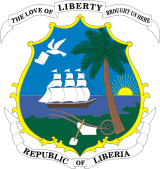
Geography of Liberia
Background to the schools Wikipedia
The articles in this Schools selection have been arranged by curriculum topic thanks to SOS Children volunteers. To compare sponsorship charities this is the best sponsorship link.
| Republic of Liberia |
 |
|
History · Politics · Demographics |
Location
Liberia is a large Sub-Saharan nation in West Africa located at 6 °N, 9 °W.
Topography
The country is shaped like a rectangle, with a shape similar to El Salvador.
Land boundaries and size
It borders the north Atlantic Ocean to the southwest (579 km of coastline) and three other African nations on the other three sides. The total length of Liberia’s land borders is 1,587 km: 306 km with Sierra Leone on the northwest, 563 km with Guinea to the north, and 716 km with Côte d'Ivoire. In total, Liberia comprises 111,370 km² of which 96,320 km² is land and 15,050 km² is water, making the country slightly smaller than the U.S. state of Washington.
Maritime Claims
Liberia currently claims a territorial sea of 200 nmi (370.4 km; 230.2 mi).
Terrain
Liberia has a mostly hilly terrain, from rolling plains along the coast to a rolling plateau and low mountains in the northeast.
Elevation extremes
The lowest point on Liberia is at sea level on the Atlantic Ocean. The highest point on Liberia is 1 440 meters above sea level at Mount Wuteve.
Climate
Liberia has a tropical climate. This means it is hot and humid throughout much of the year. The seasons are split into dry winters with hot days and cool to cold nights and wet, cloudy summers with frequent and heavy showers.
Land use and agriculture
arable land: 3.43%
permanent crops: 3%
permanent pastures: 1.98%
other: 94.59% (2005)
Irrigated land
30 square kilometres of Liberia's land was irrigated in 2003.
Natural hazards
The natural hazard that occurs in Liberia is a dust-laden harmattan wind that blows from the Sahara (December to March).
Environmental issues
Current environmental issues
Current environmental issues include the fact that the tropical rainforest is subject to deforestation; soil erosion; loss of biodiversity and the pollution of coastal waters from oil residue and raw sewage.
Environment - international agreements
party to: Desertification, Endangered Species, Marine Dumping, Nuclear Test Ban, Ozone Layer Protection, Ship Pollution, Tropical Timber 83, Tropical Timber 94
signed, but not ratified: Biodiversity, Climate Change, Environmental Modification, Law of the Sea, Marine Dumping, Marine Life Conservation



